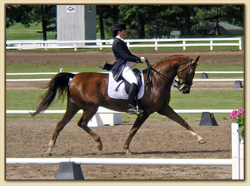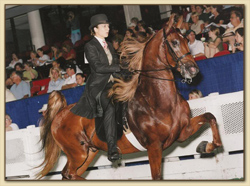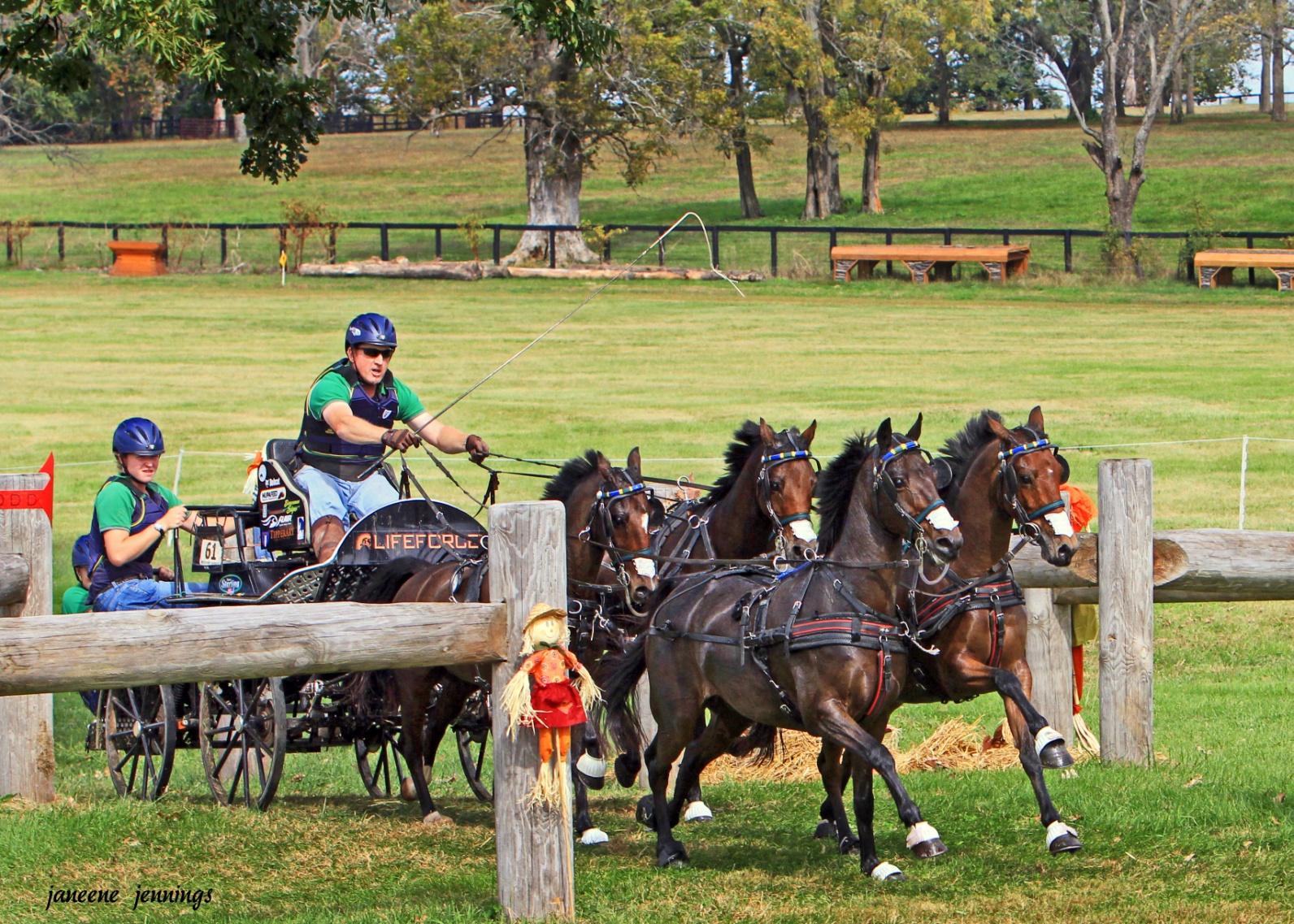The Sport Horse/Show Horse Translator
Sport horse and show horse people often butt heads. Many times after long, grueling arguments, they discover they are saying the same things just using different terminology. In the spirit of more effective communication, we offer a glossary of terms used by aficionados of each discipline.
 Sporthorse Terms
|
 Showhorse Terms
|
The Sporthorse/Showhorse Translator
Sport horse and show horse people often butt heads. Many times after long, grueling arguments, they discover they are saying the same things just using different terminology. In the spirit of more effective communication, we offer a glossary of terms used by aficionados of each discipline.
Sporthorse Terms
1. Acceptable bits: the United States Dressage Federation maintains a list of bits which are legal for use in dressage competitions, and dressage phase of eventing. These are snaffle bits with a simple joint, French, or Bristol mouths. The curb bits are generally of lower port and shank style than most show horse bits. Wire snaffles, mule bits, and bicycle chain bits are expressly forbidden.
2. Athletic: demonstrates coordination, range of motion in all joints, and is balanced in movement.
3. Bascule: the correct arc that a horse makes over a fence, using their head, neck and back, and drawing their knees up evenly, and “beneath their chin”. The horses’ entire outline should reflect a curve- like a rainbow.
4. Built uphill: the horses withers are set higher than the highest point of the croup- American Saddlebreds are quite often built this way, as opposed to Quarter Horses and Thoroughbreds, that are often “high-hipped”- the reverse of “built uphill”. It is felt that a horse that is built uphill will be more inclined toward self-carriage.
5. Clocks: used to describe jumping rounds, implying that the horse was on autopilot- “that horse just clocks around a course”.
6. Correct: generally refers to legs- straightness and symmetry of front and hind feet an legs- open heels and matching hoof angles.
7. Cracks his back: a horse that uses his head, neck, and back in an extremely athletic manner over a fence- these horses are not easy to sit on over a fence.
8. Daisy cutter: a horse that glides over the ground with a “toe flicking” movement- no motion- preferred in show hunter prospects.
9. Fancy: an attractive horse or pony that is a good mover and good jumper for the show ring.
10. Half pass: is a movement performed in competition in the trot and canter. The horse must maintain a correct bend in the direction that it is traveling, and move forward at a correct pace.
11. Hollow: used to describe a way of moving or a jumping style in which the horse is not rounded.
12. “Jerks his knees”: the ability of a jumper or hunter to pull their forearms up above level (90*) over a jump
13. Impulsion: the natural tendency of a horse to want to move forward from the leg without undue aids- the horse should not run from the leg either, but rather, wait to be asked to move forward.
14. Lateral work: work which is done on an angle, as opposed to a straight line. In lateral work, the horse must cross their legs, to some extent. In correct work of this kind, a horse is expected to move forward as much as sideways.
15. Leg yield: a basic lateral movement where the horse moves sideways, maintaining a parallel line to the outside of the arena. This is the only lateral work where the horse is not required to bend in the direction that he is going.
16. Lengthenings: the beginning of asking a horse for extended gaits. A lengthening should show a horse making the stride longer- not faster- the highest form of a lengthening is an extension- where the horse should appear to float in the gait.
17. Line: a sequence of fences.
18. Mannerly: For this purpose, refers to a horse that will stand to be mounted from the ground, is not girthy, mouthy, etc.
19. Moves from behind: the horse has an active, driving hind end, and steps up under himself to push forward.
20. Moves uphill: the horse steps up under itself, and transfers weight from the forehand to the hindquarters.
21. On the bit: the horse maintains a consistent and even contact through the reins to the rider.
22. On the muscle: describes a horse that is full of himself, and may play and run through the bridle.
23. Over-bent: refers to a horse that is trying to avoid the bit by over flexing at the poll OR to a horse that is moving his head and neck to the inside of a circle, but keeps his body in a straight line (as opposed to having his entire body reflect the diameter of the circle).
24. Over-track: tracks of the hind feet exceed those of the forefeet in the gait.
25. Packer: a horse that know his job well enough, and is honest enough, to take care of his rider.
26. Pirouettes: a turn in place done in the rhythm of the gait. The horses hindquarters should stay as close to the center of the circle that is created as possible. Walk and canter pirouettes are required movements in third and fourth level, respectively (check).
27. Round: describes the arc that a horse makes over a fence (head and neck stretched forward, good propulsive effort from behind). In dressage, this describes a horse that is tracking up, engaging the hindquarters, and holds its head and neck in the proper arch.
28. School Master: a dressage horse that knows his job well enough to teach it.
29. Self carriage: the ability of a horse to balance themselves, with minimal aids from the rider, in a correct frame.
30. Short girth: many dressage saddles are made with long billets, and therefore require a short girth, as opposed to short billets, and a regular girth. The purpose is mainly to move the buckles down out of the riders way, and allow for greater comfort and contact.
31. Simple change of lead: in dressage, these are executed through the walk, as opposed to Saddle Seat, where the horse is halted before commencing canter on the other lead.
32. Suspension: is most easily understood as “hang time” in a horses movement- much like the movement of a horse that is flagged.
33. “Swaps his leads”: describes a horse that knows how to do flying changes of lead at the appropriate point in a course.
34. Tempi changes: a dressage term, these are flying changes of lead. The horse must complete the change of lead in stride- both front and back- and stay as straight as possible. In competition, they are executed every fourth, third, second and every other stride. These are commonly called “fours, threes, twos and ones”.
35. “Ten” mover: a hunter that moves with a ground covering low stride, often with a bit of suspension.
36. Through: dressage term indicated that a horse is engaging and using its body from hindquarter “through” to the hand.
37. Topline: a horse’s profile from ears to tail.
38. Tracks up: the hind feet drive forward into, or past, the tracks of the forefeet indicating greater hind end activity- not usually possible or desirable for a horse in show shoes.
39. Cold backed or girthy: these are terms that are not exclusive to show horses. A cold backed horse would be one who is not immediately comfortable when a rider mounts, and might “hump up” in their back- a girthy horse is one who is not comfortable with a tight girth, and the girth either needs to be kept loose, or tightened after the horse warms up .
Showhorse Terms
1. Bitting rig: a surcingle with side reins attached. Used in the stall, loose in the ring or arena, or on a lunge.
2. Bounce walk: three and five gaited horses are expected to execute a two beat gait that is essentially an animated jog, rather than a flat footed walk.
3. Canter aids: for a show horse, the horse is turned toward the rail, from a walk, and the outside leg signals the canter.
4. Cold backed or girthy: these are terms that are not exclusive to show horses. A cold backed horse would be one who is not immediately comfortable when a rider mounts, and might “hump up” in their back- a girthy horse is one who is not comfortable with a tight girth, and the girth either needs to be kept loose, or tightened after the horse warms up.
5. Colt bridle: a bridle with a running martingale and two sets of reins (one above the martingale rein), or German martingale, with a snaffle bit attached.
6. Cut tail: a show horse in most divisions is expected to have their tail up over their back. In order to accomplish this, muscles on the side of the tail are cut, allowing the tail to go up. The tail is kept in a tail set, in order to keep these muscles from growing back in. Tail straightness and length are extremely important to the show horse aficionados.
7. Dumb jockey: a training device with a surcingle which has a pole coming out of the top, allowing reins to be attached at a higher placement than is possible with a plain surcingle.
8. Flat shod or in plates: indicates a horse with a keg shoe on.
9. Forward-headed: A neck set which does not easily allow a horse to carry the underside of their neck perpendicular to the ground when working.
10. Full bridle: a bridle as used on show horses, with a snaffle and curb bit on it, two sets of reins, and a bradoon hanger for the snaffle bit. Usually, a colorful browband and occasionally, a matching caveson are used for showing.
11. Game: a horse with an intense desire to please and go forward. This is very desirable in a high quality show horse.
12. Good order: a horse that is in acceptable weight and condition. High order could be the best type of condition, and “no kind of order” is an example of a phrase describing a horse in poor condition.
13. Harness horse: refers to a fine harness horse- these horses typically must have high collected animated motion. They are judged at the walk, trot and park trot ( a slightly stronger trot).
14. Hingey: indicates a horse that has the conformational ability to set his head in a show horse headset. Usually this would include a somewhat “S” shaped neck.
15. Hocks: the ability of a horse to use their hind end. A horse who pulls their legs up, closing the angle on all hind end joints would be desirable.
16. Hooky or double hinge: refers to a horse with whose neck has almost an “s” curve to it, allowing them to pick up their head higher, and set their chin closer to their chest. For show horse purposes, the underside of the neck should be perpendicular to the ground.
17. Jog: driving a horse using a jog cart- a sulky like cart usually with bicycle tires. One of the preferred ways of working show horses.
18. Long line: ground driving a horse with two lines- can be done on a circle, or up and down an arena wall. Usually referred to as “lining”- a preferred method of working show horses.
19. “March a trot”: used when a horse has the ability to demonstrate correct motion in front and hind ends, at a correct cadence.
20. Motion: the ability of a horse to lift their legs. “Level” describes motion that has the horses forearm parallel to the ground.
21. Necky: refers to a horse with a longer, more swanlike neck.
22. Oily: describes a horse with seamless, smooth movement.
23. Park out: originally for ease of mounting when ridden, and to exaggerate the desirable flat top line for showing a horse on the line or in photos, the American Saddlebred stance shows the horse with his front legs essentially perpendicular to the ground, and his hind legs placed well behind him, and square with one another.
24. Rack: the second of the “man made” gaits- a fast animated four beat gait without a tendency to being lateral or pacey.
25. Shatner horse: refers to a western division designed for horses who are not expected to have a lot of front or hind end action, but with good manners. This division has several classes including obstacle classes, much like trail classes at western shows. These classes take their name and inspiration from William Shatner.
26. Show shoes: usually hand made shoes with toes clips that are put on with one or more leather pads. Each horse is custom shod to best aid them in the desired movement.
27. “Sight” (to behold): a common description for an exceptional horse- “he is a sight”.
28. Slow gait: the first of the “man made” gaits- a slow, animated four beat gait. This gait should not be pacey.
28. Soft or low in the back: a horse who has a sway back. This can be of varying degrees- soft would be the least dramatic of these. Show horses can still be quite talented with a low back. Usually due to the presence of Lordosis.
29. Stretchies: also called “shackles” or “do-gooders” or “developers” are ankles straps, usually covered in sheepskin fleece, with dee rings, and a length of surgical tubing tied between them. This training device is used to develop the front end of a horse, causing them to draw their knees up higher and tighter, and move with greater suspension.
30. “Tie” a class: this is the order that the ribbons are awarded in a class- as in “he tied sixth” or, in the case of not receiving a ribbon “he tied out”.
31. Walk-trot: a three gaited horse- these horses are shown with a roached mane, and a tail with the base trimmed. They should be very refined, and are shown at the walk, trot, and canter. The walk should be animated- the trot high and floating, and the canter slow and rocking.
32. Ways of the ring: show horses are worked and shown on the left rein- the first “way” of the ring when starting a workout, and on the right rein, the second “way” of the ring after this.
33. Wears Himself: indicates a horse that sets his head in the proper frame for show horse work.
34. Wears his ears right: a show horse is expected to have their ears forward at all times in the ring, and while working. A horse that “never backs an ear” or “never turns an ear” would be the equivalent.

